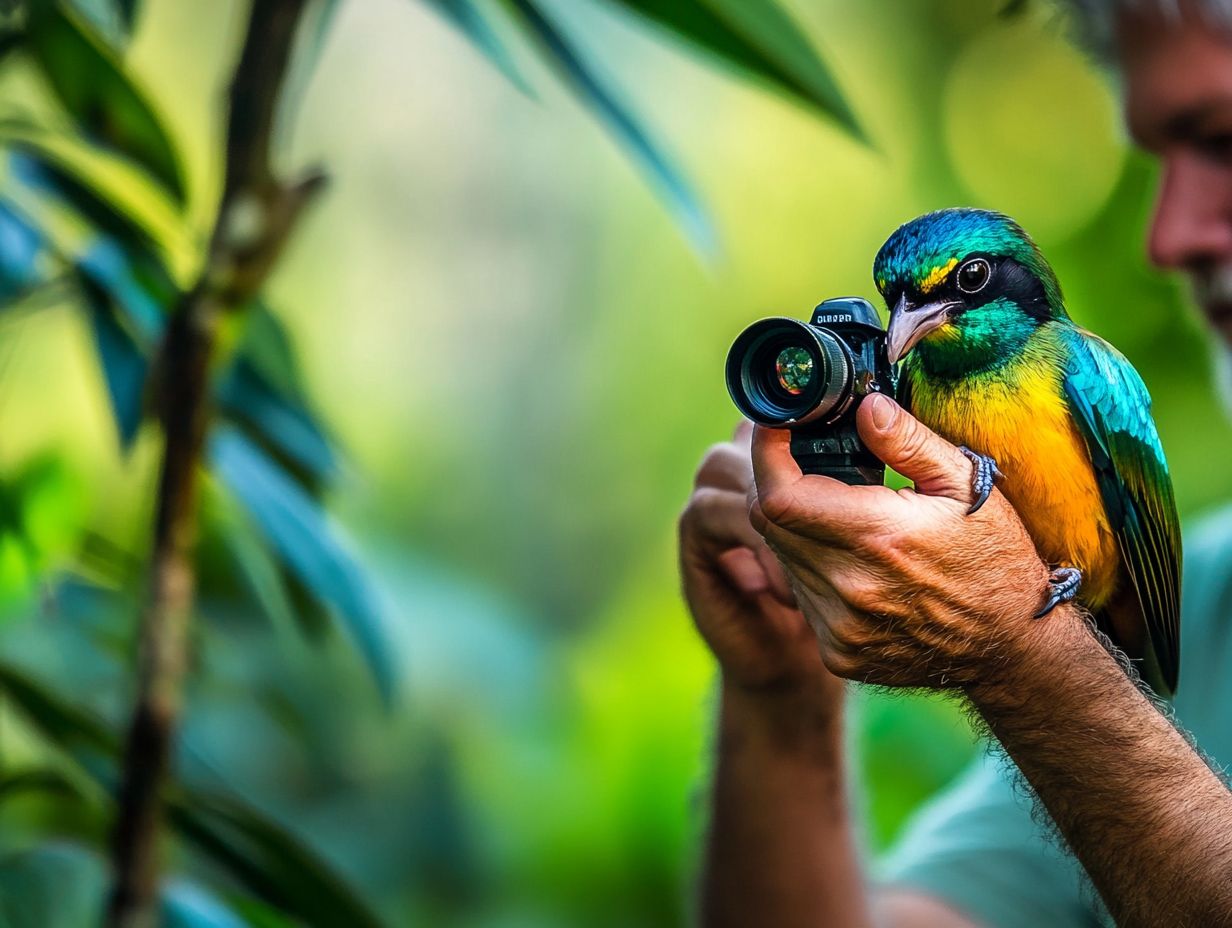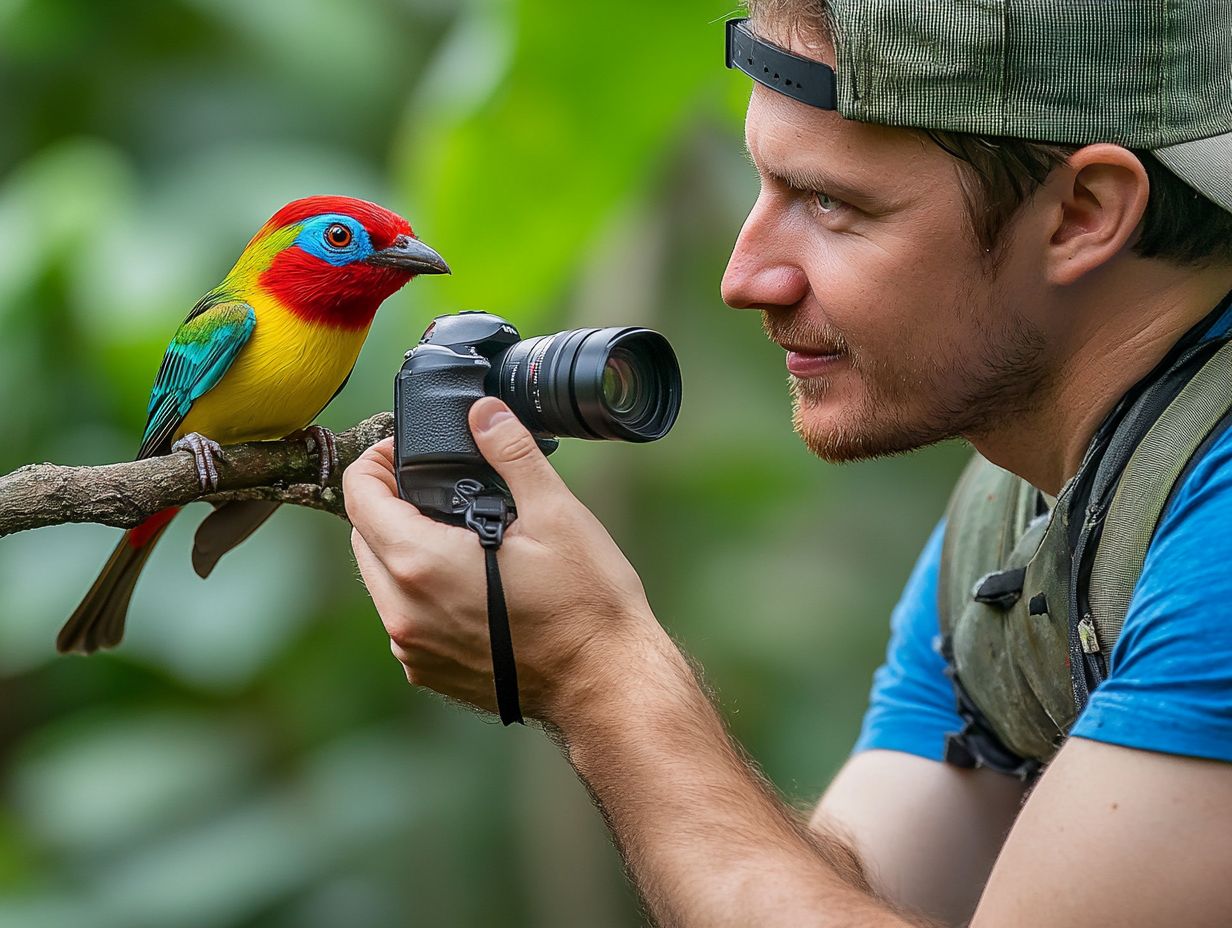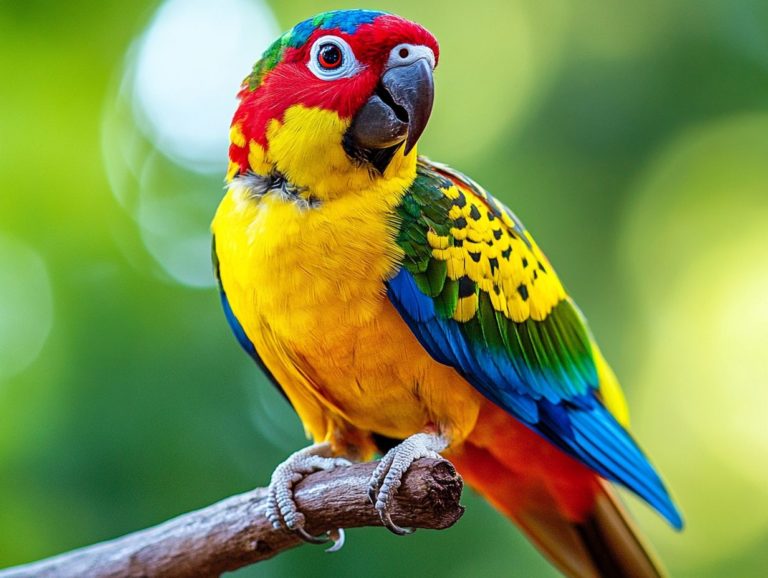How to Improve Focus in Bird Photography
Bird photography is a captivating art form that offers a unique connection with nature. The secret to capturing stunning images of these hard-to-find birds lies in one critical element: focus.
This piece delves into the importance of focus in bird photography, examining the factors that can affect it and providing practical tips to elevate your shots. From selecting the right equipment to steering clear of common pitfalls, this guide is designed to help you take your bird photography to new heights.
Contents
- Key Takeaways:
- The Importance of Focus in Bird Photography
- Factors Affecting Focus in Bird Photography
- Tips for Improving Focus in Bird Photography
- Common Mistakes to Avoid
- Frequently Asked Questions
- How can I improve focus in bird photography?
- Is it important to have a good camera for bird photography?
- How can I track a bird’s movements for better focus?
- What is the best lighting for bird photography?
- How can I improve my composition in bird photography?
- Do I need a lot of expensive equipment for bird photography?
Key Takeaways:

- Focus is crucial in bird photography as it can make or break the quality of your images.
- Environmental factors and camera settings play a significant role in determining focus, so be aware of your surroundings and use the right techniques.
- Improve focus by investing in the right equipment and being patient and persistent in your pursuit of the perfect shot.
What is Bird Photography?
Bird photography is a captivating realm within wildlife photography, inviting you to capture breathtaking images of birds in their natural habitats. Bird photography isn’t just about having a good eye; it s about understanding birds and knowing your camera to produce high-quality images.
You want to showcase the beauty and intricacies of bird life while honoring their environment. As you embark on this journey, you’ll likely face challenges, from hard-to-find birds to unpredictable lighting conditions. The pursuit of that perfect moment can be both rewarding and demanding.
For instance, when photographing the Great Tit (Parus major), you ll need to grasp its behavior; patience is essential, as these lively birds flit about quickly, requiring you to anticipate their movements.
Using techniques such as a telephoto lens allows you to maintain a respectful distance without disturbing the birds, while burst mode can be your best friend for capturing those rapid-fire moments. Being adept in post-processing will further elevate your photographs, highlighting the unique characteristics of each species and immersing viewers in the enchanting world of bird life.
The Importance of Focus in Bird Photography
Getting your focus right is crucial for capturing sharp images that reveal the intricate details of your subject, especially when you’re working with fast-moving birds and exploring techniques like how to photograph birds with different backgrounds.
Use effective focus techniques like single point focus and back button focus to ensure the main subject stands out against its surroundings. This approach allows you to showcase the beauty of birds with remarkable clarity and depth. For those looking to enhance their skills, understanding exposure for bird photography can elevate your photography even further.
Why Focus is Crucial for Capturing Birds
Focus is essential in bird photography, as it directly influences the sharpness and clarity of your images, particularly when capturing subjects in motion. By employing focus strategies like continuous focus mode (AF-C mode) and understanding how to use composition to enhance bird photos, you can adeptly respond to the unpredictable movements of birds, making sure each shot captures their essence and vitality.
Knowing the differences between bird species will improve your photography. For example, photographing birds in flight often requires a different approach than capturing those perched serenely. By anticipating their movements and utilizing techniques such as spot focus or tracking modes, you’ll achieve sharper results. Understanding the basics of bird photography composition can further enhance your skills.
Adapting your settings to suit lighting conditions is also crucial; in low light, increasing the ISO not only bolsters focus but also reveals the intricate details of plumage. Thoughtful focus enhances clarity and allows you to tell a richer story about the vibrant world of bird life.
Factors Affecting Focus in Bird Photography
Numerous factors can profoundly impact your focus in bird photography, such as environmental conditions, camera settings, and the techniques you choose. To ensure you’re ready, preparing for a bird photography outing is crucial. Don’t let these factors ruin your shot; knowing them will help you take amazing pictures.
By understanding these influences, you can elevate your skills and capture striking, crisp images of birds in their natural glory.
Environmental Factors

Environmental factors are pivotal in bird photography, shaping both the focus and overall quality of your outdoor images. Elements such as lighting conditions, weather patterns, and various habitat types influence bird behavior and dictate how you should manage your equipment and settings to achieve the best results.
Consider the difference between the gentle illumination of early morning and the harsh glare of the midday sun. These varying light conditions can drastically alter your exposure settings. When faced with bright sunlight, it is wise to adjust your camera settings to prevent blown-out highlights, perhaps by increasing the shutter speed or tweaking the aperture. In low-light scenarios, raising the ISO can help you capture those fleeting moments while maintaining image clarity.
To counteract potential camera shake that could undermine your stability, employing a tripod or utilizing your camera s stabilization features can significantly enhance image sharpness especially when you are working with longer lenses or shooting at slower shutter speeds.
Camera Settings and Techniques
The right camera settings and techniques are vital for achieving precise focus in bird photography, where flexibility is key to meeting both your needs as a photographer and the behavior of your feathered subjects. Learning how to use natural light in bird photography can enhance key settings like shutter speed and image stabilization, playing a significant role in improving the sharpness and clarity of your photographs.
For the best results, set your shutter speed to at least 1/1000 of a second, particularly when working with agile birds that seem to defy gravity. Image stabilization is another crucial factor; using a tripod or a gimbal head (a support that helps stabilize the camera) can greatly reduce blur caused by any unintended movements.
Regarding autofocus, consider using continuous or AI tracking modes, which help your camera maintain focus on birds in motion with impressive accuracy. Familiarizing yourself with burst mode is also a smart move, as it provides you with a series of frames that significantly boost your chances of capturing that elusive perfect shot.
By skillfully blending these techniques, you will achieve remarkable results in your bird photography endeavors.
Tips for Improving Focus in Bird Photography
To elevate your focus in bird photography, you need a blend of the right equipment and effective techniques that address the unique challenges of capturing birds in their natural habitats. A key aspect is learning how to stay hidden while bird photography. By choosing the appropriate gear, mastering focus adjustments, and applying tried-and-true photography tips, you can dramatically enhance your ability to capture sharp, dynamic images of your feathered subjects.
Choosing the Right Equipment
Choosing the right equipment is absolutely essential for capturing high-quality bird photographs, as it directly impacts your ability to achieve sharp focus and detail. Opting for camera models like the Canon R5 and high-quality telephoto lenses can significantly boost your chances of capturing birds in stunning clarity.
As you consider your gear, evaluate the specifications that best align with your unique style and the types of birds you aim to photograph. For instance, a high frame rate and advanced autofocus system can make all the difference when it comes to snapping fast-moving subjects. A crop sensor might be your best friend for reaching distant wildlife.
Finding the right balance between your camera’s capabilities and lens quality is crucial. A stable tripod can help mitigate the effects of camera shake, ensuring that even the tiniest details in feather patterns and colors are preserved.
Ultimately, investing in the perfect combination of camera body, lens, and accessories will enable you to fully immerse yourself in the captivating world of birdwatching.
Start experimenting with these techniques today and watch your bird photography soar!
Practicing Patience and Persistence
Practicing patience and persistence is essential in bird photography. Understanding bird behavior can significantly enhance your chances of capturing remarkable images.
Many photographers miss golden opportunities simply because they lack the patience needed. Birds often require time to engage in their natural antics and reveal their true beauty.
Imagine sitting silently for hours, waiting for a heron to strike a pose or a hummingbird to hover gracefully near a flower. By observing these creatures, you can gain insight into their feeding habits, nesting behaviors, and social interactions.
This knowledge will help you anticipate their movements and be poised for that perfect shot.
Adapting to changing conditions, whether it s light or weather, is crucial. After all, patience can mean the difference between a rushed, mediocre photo and a breathtaking, well-composed image.
Take the time to blend into the environment and study how the birds move and interact. As you do, the remarkable rewards of stunning photos will surely follow.
Common Mistakes to Avoid

In bird photography, steering clear of common mistakes is crucial for enhancing image quality and achieving overall success.
Blurred images from improper focus and missed opportunities due to inadequate preparation can stand in the way of capturing breathtaking photographs.
It s essential for photographers to remain vigilant about their techniques and equipment to truly excel in this art form.
Blurred Images
Blurred images can be a frustrating challenge in bird photography. They often stem from camera shake or an incorrect focus point, which diminishes the overall quality of your shots.
By understanding the root causes of blurriness and employing strategies like image stabilization, you can significantly enhance the sharpness of your images.
Environmental factors, such as low light conditions and the swift movements of your subject, can further complicate the quest for clarity.
To tackle these issues, consider using a tripod or a monopod to add stability, especially in tricky situations where camera shake is more likely.
Choosing the right autofocus mode a setting that helps your camera focus on moving subjects like continuous tracking, can help you keep pace with fast-moving birds.
You can also use a higher shutter speed to freeze motion, making a big difference in the clarity of your images. These small adjustments can lead to remarkable improvements in your overall photographic results.
Missed Opportunities
Missed opportunities in bird photography often stem from inadequate preparation, slow reaction times, or an inability to adapt to changing conditions.
These moments can be particularly exasperating. Capturing those fleeting glimpses of bird behavior hinges on quick focus adjustments and responsive techniques.
To elevate your chances of success, invest time in understanding the habits and movements of your avian subjects. Observing their flight patterns, feeding routines, and preferred habitats will enable you to anticipate their actions.
For example, positioning yourself in a likely landing spot with a pre-focused lens can make a world of difference in those split-second moments.
When shooting in dynamic environments like wetlands or during migration using burst mode helps ensure that even the swiftest movements are flawlessly captured.
Regularly practicing focus techniques in varied lighting and environmental conditions will enhance your skills. This will make you more adept at adjusting settings on the fly.
Frequently Asked Questions
How can I improve focus in bird photography?
One way is to use a fast shutter speed to capture the bird’s movement. Another is to use a telephoto lens with a narrow depth of field. Additionally, you can use the focus lock feature on your camera to keep the bird in focus as it moves. For more tips, consider exploring techniques for photographing birds in flight, which is especially useful when employing eye tracking techniques.
Is it important to have a good camera for bird photography?

A good camera can improve your bird photography, but it isn t essential. With the right techniques, you can capture stunning bird photos even with a basic camera.
How can I track a bird’s movements for better focus?
Use a tripod or monopod to stabilize your camera. This gives you better control and helps you follow the bird’s movements more accurately.
Enable the continuous autofocus feature on your camera to keep the bird in focus as it moves.
What is the best lighting for bird photography?
Natural light is best for bird photography. Shoot during the golden hour after sunrise or before sunset for a warm, soft glow.
Avoid harsh midday sunlight, as it creates strong shadows and washes out colors in your photos.
How can I improve my composition in bird photography?
Get down to the bird’s eye level for a more engaging perspective. Use techniques like the rule of thirds and leading lines to enhance your compositions.
Be patient and experiment with different angles to find that perfect shot!
Do I need a lot of expensive equipment for bird photography?
You don’t need expensive gear for bird photography. A zoom lens helps capture birds from afar, but even a basic camera with a teleconverter can work wonders.
Use a tripod, monopod, and remote shutter release for stability. Most importantly, be patient and dedicated to improving your skills!






